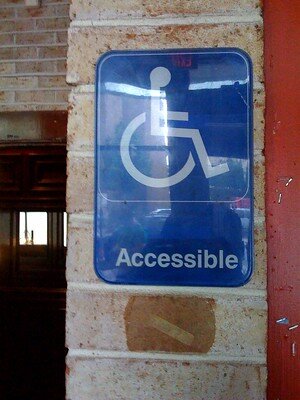Source: flickr/Patrick Haney
by Linda McKay-Panos
Reposted from LawNow 45(6) with permission
According to Statistics Canada (2017), 22% of Canadians over the age of 15 live with at least one disability that limits their everyday activities. Federal and provincial human rights legislation prohibit discrimination based on mental and physical disability. However, many believe there is a need to proactively address systemic barriers.

by Linda McKay-Panos
Reposted from LawNow 45(6) with permission
The Accessible Canada Act and similar legislation in four provinces address systemic barriers of accessibility.
According to Statistics Canada (2017), 22% of Canadians over the age of 15 live with at least one disability that limits their everyday activities. Federal and provincial human rights legislation prohibit discrimination based on mental and physical disability. However, many believe there is a need to proactively address systemic barriers. In 2019, Canada passed the Accessible Canada Act (ACA), which applies to matters under federal jurisdiction (e.g., banks, communications and transportation). In the preamble, the ACA recognizes the existing human rights framework that supports equality for people with disabilities in Canada. This includes:
· the Canadian Charter of Rights and Freedoms
· the Canadian Human Rights Act, and
· Canada’s commitments as a State Party to the United Nations Convention on the Rights of Persons with Disabilities
The federal government notes that the ACA builds on this framework through a proactive and systemic approach that identifies, removes and prevents barriers to accessibility. According to the Federal Accessibility Legislation Alliance. a barrier is “anything that does not allow people with disabilities to be included and take part in all areas of life and society. Barriers prevent people with disabilities from taking part in the same way that people without disabilities can”.
The ACA defines barrier as:
barrier means anything — including anything physical, architectural, technological or attitudinal, anything that is based on information or communications or anything that is the result of a policy or a practice — that hinders the full and equal participation in society of persons with an impairment, including a physical, mental, intellectual, cognitive, learning, communication or sensory impairment or a functional limitation.
The purpose of the ACA is stated:
5 The purpose of this Act is to benefit all persons, especially persons with disabilities, through the realization, within the purview of matters coming within the legislative authority of Parliament, of a Canada without barriers, on or before January 1, 2040, particularly by the identification and removal of barriers, and the prevention of new barriers, in the following areas:
(a) employment;
(b) the built environment;
(c) information and communication technologies;
(c.1) communication, other than information and communication technologies;
(d) the procurement of goods, services and facilities;
(e) the design and delivery of programs and services;
(f) transportation; and
(g) areas designated under regulations made under paragraph 117(1)(b).
The Accessibility Commissioner enforces the ACA. They can use a range of tools to ensure that organizations are meeting their obligations under the ACA. These include:
· inspections
· production orders (ordering an organization to provide records and reports)
· compliance orders (ordering an organization to correct a contravention, and to take steps to ensure the contravention does not happen again)
· notices of violation (notices setting out a warning or requiring an organization to pay a penalty of up to $250,000 per violation), and
· compliance agreements (when an organization agrees to correct a violation within set terms)
Four provinces have passed or will soon pass similar legislation to address accessibility barriers for matters under provincial jurisdiction. Ontario was the first to pass provincial legislation in 2005. The Accessibility for Ontarians with Disabilities Act, 2005 (AODA) serves as a model for both the ACA and all following provincial accessibility legislation.
Manitoba and Nova Scotia passed similar acts in 2013 and 2017 respectively. British Columbia recently introduced Bill 6, the Accessible British Columbia Act.
“The federal government has voiced a hope that the remaining provinces will follow suit in legislating at least the same level of standards as those established under the ACA.”
According to the Alberta Ability Network (AAN), like some other provinces and territories, Alberta’s current disability policy exists as a patchwork of legislation. Alberta’s legislation is made up of:
· Acts addressing specific aspects of accessibility (e.g., the Service Dogs Act)
· Acts dealing with other issues but which contain clauses on how disability affects the administration of that focus (e.g., the Student Financial Assistance Act)
AAN points out there are 30 current pieces of legislation in Alberta related to disability and accessibility. However, there are no central principles ensuring a consistent approach to accessibility.
[T]he only central principle in Alberta legislation comes from the Alberta Human Rights Act, which includes physical and mental disability in its list of prohibited grounds for various types of discrimination. This, however, does not establish an active duty to accommodate. WCB legislation requires accessibility of employers when an injured employee returns to work, but legislation extending that expectation broadly is quickly becoming the norm.
AAN is a coalition of 170 organizations that believe Alberta’s current human rights legislation is unclear about how to prevent discrimination against people with disabilities. The Alberta Accessibility Legislation Advisory Group of the AAN met with Alberta government officials to encourage them to pass provincial accessibility legislation. At a meeting on April 13, 2021 with MLA Nate Horner, the AAN made recommendations to ensure future accessibility legislation is “strong and effective”. On May 5, 2021, MLA Horner communicated the following recommendations in a letter written to government:
· Remove and prevent barriers that affect people with disabilities in a variety of sectors
· Apply to all areas under provincial jurisdiction
· Set out clear requirements and not rely on voluntary compliance
· Include mechanisms for enforcement of accessibility standards
· Provide the disability community a meaningful role in the development of accessibility standards
· Set a timeline for making Alberta fully accessible, and
· Include built-in, regular reviews of the legislation to measure progress.
Nova Scotia’s law, mentioned above, deals with potential conflicts between existing provincial provisions and new accessibility legislation. The preamble states that in areas of perceived contradiction, the Accessibility Act supersedes all previous law. The exception is where that law guarantees a higher standard of care and accommodation. It is believed that following this example in Alberta will avoid some complications experienced in Ontario and Manitoba.
It will be very interesting to see which jurisdictions across Canada will follow the federal government’s lead in addressing the accessibility issues faced by many Canadians.




2500 University Drive NW
Calgary, AB T2N 1N4
(403) 220-2505
aclrc@ucalgary.ca